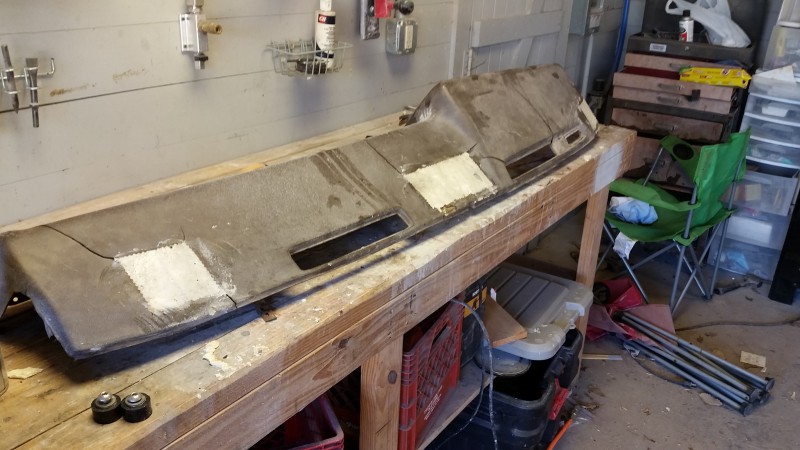
 |
Register or Log In To remove these advertisements. |
|
|
|
|||||||
|
|
Thread Tools | Display Modes |
|
|
#1 |
|
Registered User
Join Date: Apr 2014
Location: Beaumont, TX
Posts: 34
|
My DIY Dash Restoration
My post on my door panel restoration (seen here) generated some interest for my dash restoration, so here goes nothing. This is a step by step look at what we did to restore the dash from a 1984 GMC Stepside.
When we pulled the dash out initially, we had no intentions of fixing it because it was in such bad shape. In fact, we left it outside for a while! But as the end of our restoration project gets nearer, the financing pool is getting emptier. So after seeing that some other people had restored their dashes, we decided to give it a whirl, and I'm glad we did! Here is the dash in all it's nastiness:   The first thing we did was cut out all of the cracks and damage, including removing the completely rotted speaker grilles. My son decided that he didn't want in-dash speakers, and so for a cleaner look we decided to just fill in all of the speaker areas. We taped some cardboard on the undersides of the dash where the grilles were, and then filled all the voids with spray foam insulation. We then took a serrated knife and cut the foam off even with the surface of the dash.  If I had it to do over again, I might have just left what remained of the speaker grilles and foamed in and around them to give it a little bit more support. The thin layer of foam gave me a tiny bit of problem when I was sanding later due to its flexibility. The next step was to cut out all the material that had cracked in order to remove any raised part of the vinyl. I should have sanded the edges down a bit more than I did, because it caused me some problems with the filler later on. The more gradual the edge, the better the filler bonds with it. For filler I used Padded Dash Filler from Urethanesupplycompany.com. It is better than regular body filler because it is built to expand and contract with the conditions, rather than being solid and immovable. It was a little over 20 bucks a pint, and I ended up buying two due to the fact that I had so much to fill with the speaker grille voids. If you are just filling cracks, one should be plenty.  Once the filler was dry, I sanded it first with a jitterbug sander and 60 grit, then moving to 120. Once I had the shape mostly accomplished, I moved to a hand block sanding. For the edges and for the vent holes and VIN window, I had to use a Dremel with a sanding attachment to get into the small places. This process was very similar to body work, if you've ever done any of that. I had to sand, reapply, and sand, and reapply to get it just right. I ended up with a "skim coat" of filler in the major areas to make sure that it feathered out enough to have a fairly uniform smoothness and surface. This process takes a lot longer to do than to describe. I probably spent 4-5 hours on this part over the course of a few days in order to let the filler cure properly. Once I had it the way I wanted it, I went over the entire dash with a jitterbug and 220 grit sandpaper. Then came a cleaning with wax and grease remover and two coats of plastic adhesion promoter.   Next came the texture coat. I used texture coat for a couple of reasons: first, I wanted to hide any minor differences in the surface and second, I had sanded off most of the previous texture. Oh, and I wanted my door panels to match texture-wise as well. I used SEM Texture Coat and gave it about 6 coats of texture. Then I gave it a light sanding with 800 grit to ensure a uniform appearance.   Next came the paint. I wanted to color match the red paint of the interior, so I had to spend a little more than I wanted on paint. I ended up getting PPG Deltron DBC which was around 100 bucks a pint. But I had enough for my dash, my door panels, and I think I have enough to do the rest of the plastic trim as well. The paint went on very nicely.   Here you can see how well it matched the original paint, that is the glove box under the dash:  When I painted the dash, I also painted the vent inserts (the square ones on top, not the heater/ac) after a couple of coats of plastic adhesion promoter. One mistake I made is that I hadn't sanded down the hole for the insert in one place good enough and when I pushed the insert down, it was a little tight, and I ended up with a hairline crack in the corner. I put some clearcoat on it, and don't expect it to cause any problems, and it's not really noticeable. Also, there were a couple of small cracks (less than a half of an inch) in some hard to see places that I missed until I painted it. They will likely be hidden by the trim/vents. I haven't put the dash back in yet, but all in all I'm pleased. There are a couple of places in which you can see a small difference in surface, but nothing to complain too much about. This wasn't a super-easy job, but I think it is very doable! If you have any questions, let me know, I'd love to help. |
|
|
| Bookmarks |
|
|